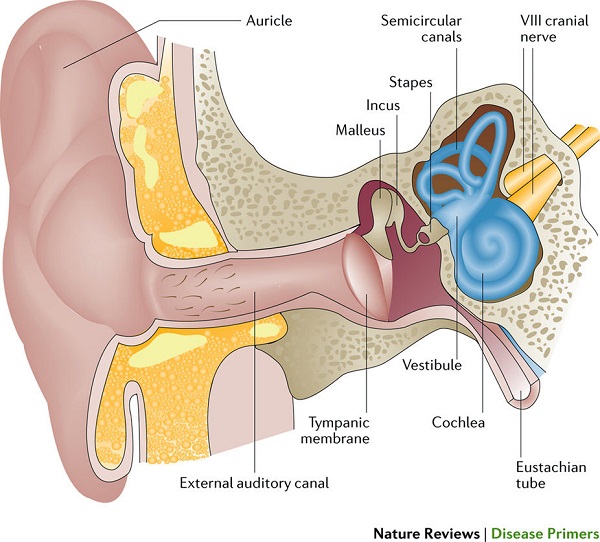先天性難聴
Congenital hearing loss
2017年1月20日 Nature Reviews Disease Primers Article number: 16094 (2017) doi: 10.1038/nrdp.2016.94

先天性難聴(生まれつきの難聴)は、小児の慢性疾患の中で最も頻度が高い。そのため、多くの先進国が新生児の聴力スクリーニングプログラムを実施して早期発見に努めている。早期介入を行うことで、言語発達の遅延が未然に防がれ、社会的・情緒的発達やQOLへの有益性が長期に及ぶ。難聴と診断されると、通常、基礎的病因の特定が行われる。低所得国での先天性難聴の原因は、このような地域でしばしば見られる環境と出生前要因に起因すると考えられている。先天性感染症、とりわけ、サイトメガロウイルス感染症も難聴の危険因子としてよく知られている。一方、先進国では遺伝的要因が主な原因になると推測されている。遺伝子の変異によって、聴覚経路に関わる要素、特に内耳のホメオスタシス(内リンパの産生と維持)と機械電気変換(機械的刺激の電気化学的活性への変換)が影響を受ける。難聴の基礎的な原因が明らかになると、治療の意思決定がなされるか、あるいは予防および(遺伝子)カウンセリングが行われる。先天性難聴の管理では、特定の抗菌薬治療、頭蓋顔面異常の外科手術、植込型/非植込型の補聴器の使用などが行われる。難聴の基礎的な病態生理や分子機構への理解が深まり、最近の遺伝子検査の進歩に対する認識が高まることで、新しい治療法やスクリーニング戦略の開発が促進されるだろう。
PrimeView
先天性難聴の頻度は小児1000人当たり最大3人といわれている。この疾患によって言語発達のみならず、情緒的発達や認知発達が著しく障害される。このPrimeViewでは、新生児の聴力スクリーニングプログラム、ならびにこの疾患の管理における早期診断の重要性を中心に取りまとめる。
本Primerの図解サマリー
Congenital hearing loss (hearing loss that is present at birth) is one of the most prevalent chronic conditions in children. In the majority of developed countries, neonatal hearing screening programmes enable early detection; early intervention will prevent delays in speech and language development and has long-lasting beneficial effects on social and emotional development and quality of life. A diagnosis of hearing loss is usually followed by a search for an underlying aetiology. Congenital hearing loss might be attributed to environmental and prenatal factors, which prevail in low-income settings; congenital infections, particularly cytomegalovirus infection, are also a common risk factor for hearing loss. Genetic causes probably account for the majority of cases in developed countries; mutations can affect any component of the hearing pathway, in particular, inner ear homeostasis (endolymph production and maintenance) and mechano-electrical transduction (the conversion of a mechanical stimulus into electrochemical activity). Once the underlying cause of hearing loss is established, it might direct therapeutic decision making and guide prevention and (genetic) counselling. Management options include specific antimicrobial therapies, surgical treatment of craniofacial abnormalities and implantable or non-implantable hearing devices. An improved understanding of the pathophysiology and molecular mechanisms that underlie hearing loss and increased awareness of recent advances in genetic testing will promote the development of new treatment and screening strategies.

